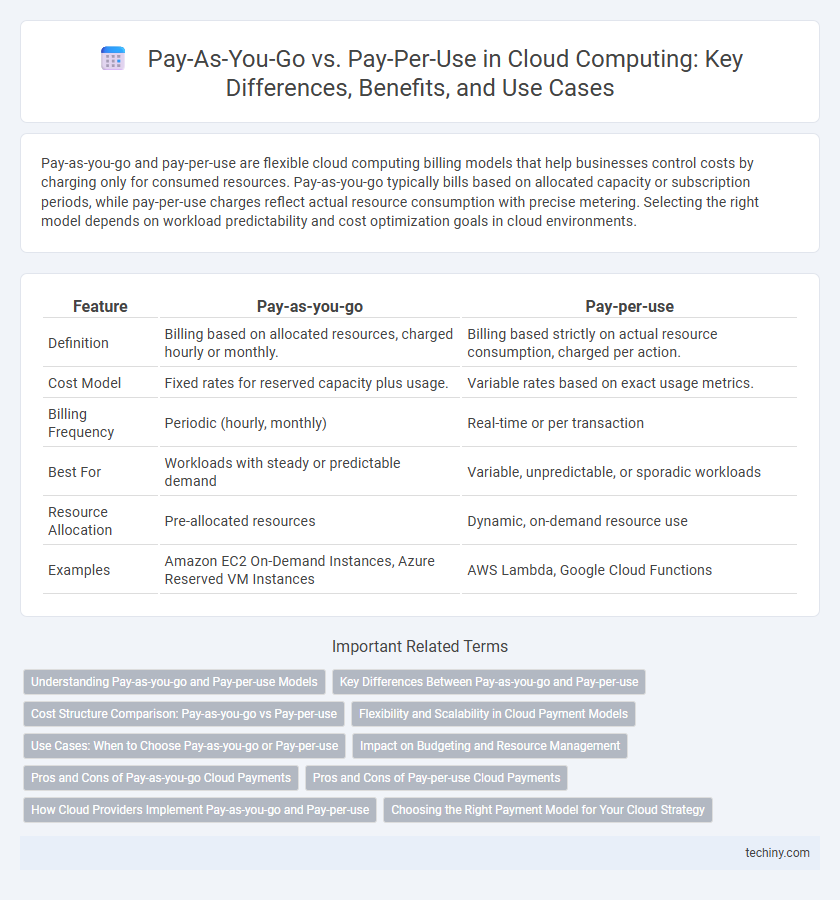Pay-as-you-go and pay-per-use are flexible cloud computing billing models that help businesses control costs by charging only for consumed resources. Pay-as-you-go typically bills based on allocated capacity or subscription periods, while pay-per-use charges reflect actual resource consumption with precise metering. Selecting the right model depends on workload predictability and cost optimization goals in cloud environments.
Table of Comparison
| Feature | Pay-as-you-go | Pay-per-use |
|---|---|---|
| Definition | Billing based on allocated resources, charged hourly or monthly. | Billing based strictly on actual resource consumption, charged per action. |
| Cost Model | Fixed rates for reserved capacity plus usage. | Variable rates based on exact usage metrics. |
| Billing Frequency | Periodic (hourly, monthly) | Real-time or per transaction |
| Best For | Workloads with steady or predictable demand | Variable, unpredictable, or sporadic workloads |
| Resource Allocation | Pre-allocated resources | Dynamic, on-demand resource use |
| Examples | Amazon EC2 On-Demand Instances, Azure Reserved VM Instances | AWS Lambda, Google Cloud Functions |
Understanding Pay-as-you-go and Pay-per-use Models
The Pay-as-you-go model bills users based on the duration of resource utilization, typically measured in hourly or minute increments, making it ideal for predictable workloads. Pay-per-use charges customers according to the exact amount of resources consumed, such as storage space or data transfer, offering granular cost control for variable demands. Both models enhance financial agility in cloud computing by aligning expenses directly with resource consumption patterns.
Key Differences Between Pay-as-you-go and Pay-per-use
Pay-as-you-go charges users based on active resource consumption over time, typically billed hourly or monthly, while pay-per-use charges are based on the actual volume of utilized services such as API calls or data processed. Pay-as-you-go models emphasize continuous resource allocation flexibility with predictable billing cycles, whereas pay-per-use offers granular cost control tied to specific service consumption events. Understanding these distinctions is crucial for optimizing cloud cost management and selecting the appropriate pricing strategy aligned with usage patterns.
Cost Structure Comparison: Pay-as-you-go vs Pay-per-use
Pay-as-you-go pricing charges customers based on allocated resources over time, often incurring costs even when usage is low, while pay-per-use pricing bills strictly for actual consumption, optimizing expenses for fluctuating workloads. In cloud computing, pay-as-you-go models may include base fees or minimum commitments, whereas pay-per-use offers granular billing aligned with precise resource consumption. Understanding these distinctions helps organizations choose cost structures that best match their workload patterns and budget flexibility.
Flexibility and Scalability in Cloud Payment Models
Pay-as-you-go and pay-per-use cloud payment models offer dynamic cost management tailored to consumption patterns. Pay-as-you-go provides greater flexibility by charging based on allocated resources regardless of actual usage, supporting predictable budgeting and easy scaling. In contrast, pay-per-use enhances scalability by billing strictly on real-time resource consumption, optimizing costs during fluctuating workloads without upfront commitments.
Use Cases: When to Choose Pay-as-you-go or Pay-per-use
Pay-as-you-go is ideal for businesses with unpredictable workloads or startups testing new applications, offering flexibility by charging only for active resources without long-term commitment. Pay-per-use suits scenarios involving highly variable or event-driven processes, such as processing large data bursts or running complex analytics sporadically, where costs correlate directly with actual usage metrics. Choosing between these models depends on workload stability, cost control preferences, and specific application demands to optimize cloud expenditure effectively.
Impact on Budgeting and Resource Management
Pay-as-you-go billing enables organizations to allocate budgets based on anticipated usage, providing predictable monthly expenses that simplify financial planning and resource allocation. Pay-per-use models charge strictly for actual consumption, allowing for flexible spending but requiring dynamic budget adjustments to accommodate variable workloads. Both approaches influence resource management strategies by balancing cost control with scalability, affecting how businesses optimize cloud utilization and investment.
Pros and Cons of Pay-as-you-go Cloud Payments
Pay-as-you-go cloud payments offer the advantage of flexibility, allowing businesses to scale resources up or down based on demand without long-term commitments, which optimizes cost-efficiency. However, unpredictable expenses may arise due to fluctuating usage patterns, potentially leading to budget overruns if not closely monitored. This model suits dynamic workloads but requires vigilant cost management to prevent unexpected charges associated with resource consumption.
Pros and Cons of Pay-per-use Cloud Payments
Pay-per-use cloud payments offer precise cost control by charging only for actual resource consumption, minimizing waste compared to flat-rate or reserved pricing models. This model enhances scalability and flexibility, allowing businesses to efficiently manage workloads with fluctuating demands while avoiding upfront commitments. However, unpredictable usage patterns can lead to variable monthly costs, complicating budgeting and potentially increasing expenses during peak periods.
How Cloud Providers Implement Pay-as-you-go and Pay-per-use
Cloud providers implement Pay-as-you-go by charging users based on allocated resource units over a billing period, such as CPU hours or storage capacity, regardless of actual consumption, enabling predictable budgeting. Pay-per-use billing tracks exact resource utilization like API requests, data transfer, or machine uptime, ensuring costs align precisely with consumption patterns. Both models leverage real-time monitoring and metering tools integrated into cloud platforms to deliver transparent and flexible payment structures for customers.
Choosing the Right Payment Model for Your Cloud Strategy
Choosing the right payment model for your cloud strategy requires analyzing your workload patterns and cost predictability needs. Pay-as-you-go offers flexible billing based on resource allocation time, ideal for fluctuating demands, while pay-per-use charges strictly based on actual consumption, benefiting users with highly variable or unpredictable usage. Evaluating performance metrics and forecasting cloud consumption helps optimize costs and maximize ROI in cloud computing deployments.
Pay-as-you-go vs Pay-per-use Infographic

 techiny.com
techiny.com